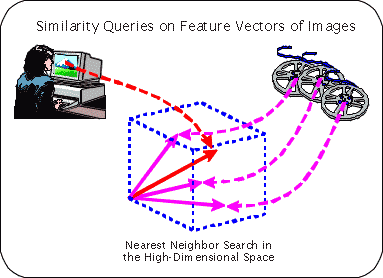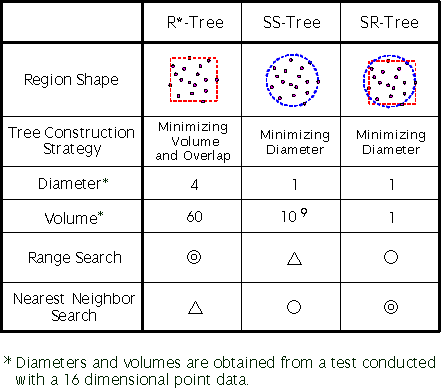 <09-Mar-2010>
<09-Mar-2010>
| Apology to Colleagues | |
|
I could not maintain the SR-tree library from 2003 to 2009.
During this period, I've even failed to respond to e-mails asking
questions on the SR-tree library.
It was a black period in my research career.
I could spend very little time for research. I sincerely apologize for any inconvenience that I caused during this period. | |
 <09-Mar-2010>
<09-Mar-2010>The SR-tree is an index structure for high-dimensional nearest neighbor queries.
One of the typical applications of the SR-tree is the similarity queries on feature vectors which is widely used for performing content-based retrieval of images [FSN+95, WKS+96].

The SR-tree is an extension of the R*-tree [BKS+90] and the SS-tree [WJ96]. The distinctive feature of the SR-tree is the combined utilization of bounding spheres and bounding rectangles. This improves the performance on nearest neighbor queries by reducing both the volume and the diameter of regions compared with the R*-tree and the SS-tree. According to our performance tests, the SR-tree outperforms the R*-tree and the SS-tree especially for high-dimensional and non-uniform data which are likely to appear in the actual image / video applications.

The ``SR-tree'' stands for the ``Sphere/Rectangle-tree''. Regrettably, after the publication of the SR-tree, we found that this name is already used in the database literature, e.g., ``Single Rotation tree'' [HW82] and ``Segment R-tree'' [KS91]. Please, do not confuse our ``Sphere/Rectangle-tree'' with these predecessors.
 <09-Mar-2010>
<09-Mar-2010>
HnSRTree-2.0beta6.tar.gz (314K bytes) for Solaris and Linux.HnSRTree-2.0beta6.zip (458K bytes) for Windows XP.
The most significant difference between version 1.3.1 and 2.0 is the source code refinement reducing CPU time. The source code is reviewed and optimized in order to eliminate redundant or inefficient implementation. In addition, some features are planned to be added in version 2.0; however they are in preparation as of version 2.0 beta 6.
HnSRTree-1.3.1.tar.gz (168K bytes)
HnRStar-1.0.tar.gz (256K bytes)
 Back to the Research Activities
Back to the Research Activities
Wednesday, 10-Mar-2010 16:05:18 JST